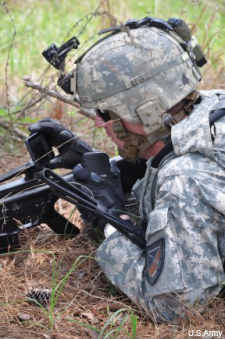Army testing a real-time smartphone system for the battlefield
The system, called SULSAT, would provide streaming video and images, giving everyone from foot soldiers to company commanders the same view.
An Army battle lab is testing a smartphone-based system that would give soldiers, platoon leaders and company commanders an identical battlefield view, fed by unmanned aerial systems and ground robots.

The Small Unit Leader Situational Awareness Tool, or SULSAT, uses controllers to collect video and imagery from the unmanned systems and stream them via Wi-Fi to the smartphones. The system would give soldiers and commanders aerial views of a tactical situation and ground views when, for example, a camera-equipped robot explores around a corner, enters a building or checks for roadside explosives.
The Maneuver Center of Excellence and the Maneuver Battle Lab at Fort Benning, Ga., demonstrated the system earlier this month at the McKenna Military Operations on Urban Terrain training area on the base.
"It increases situational awareness and maneuverability," Tony Carbone, Maneuver Battle Lab data analyst, said in an Army report. "It also increases survivability because it allows soldiers to use a robot to check for IEDs."
SULSAT is in the prototype stage and does have a few drawbacks, such as a limited range that requires soldiers to be within about 20 feet of a controller to receive imagery. It also requires some discipline on the part of users in deciding when and when not to take out the phone and look at it, one of the test’s participants told the Columbus (Ga.,) Ledger-Enquirer.
But the test largely was deemed a success and participants said they could see using SULSAT in certain situations. Spc. Timothy McCoy, who operated the tactical robotics controller, said the system was easy to use and could have its advantages, according to the Army. "I can see it being especially useful if you're trying to get a foothold in a building in village that you haven't been to before," he said.
7,000 Note IIsdetects chemical and biological threatsNEXT STORY: Predator drone to get NATO-worthy Euro radio




